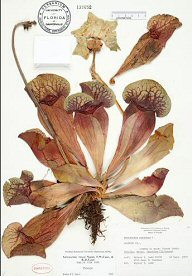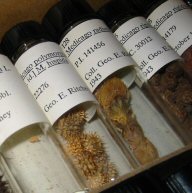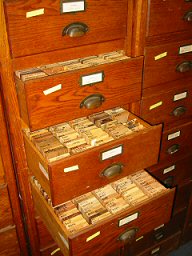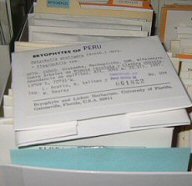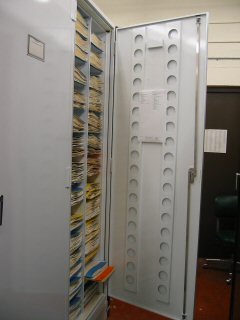What is a herbarium?
A herbarium (Latin: hortus siccus) is a collection of plant samples preserved for long-term study, usually in the form of dried and pressed plants mounted on paper. The dried and mounted plant samples are generally referred to as herbarium specimens. Other materials in the herbarium may include loose seeds, dried bulky fruits, algae, fungi, wood sections, pollen, microscope slides, silica-stored materials, DNA extractions, and fluid-preserved flowers or fruit. Herbaria (plural for herbarium) also store and manage data sets, botanical illustrations, photographic slides, images, maps, and often have libraries of relevant literature needed for consultation by researchers working with the specimens.
Herbaria are usually affiliated with universities, museums, or botanical gardens, but some may be private which was more common historically. The oldest extant herbaria date from around the 1540s, mostly associated with Luca Ghini and his botanical teachings in northern Italy. There are now around 3,500 registered herbaria in 183 countries totaling nearly 400 million specimens. Herbaria are registered through the Index Herbariorum, and each is assigned a unique official acronym (herbarium code) that is used as a standard for referring to the institution and its specimens.
Approximate list of the twelve largest herbaria in the world (also see List of Herbaria at Wikipedia and Index Herbariorum, the official registry):
| ACRONYM | LOCATION | NAME | SPECIMENS (CA. MILLIONS) |
|---|---|---|---|
| K | London, U.K. | Royal Botanic Gardens, Kew | 8.1 |
| P, PC | Paris, France | Museum National d’Histoire Naturelle | 8 |
| NY | New York, USA | New York Botanical Garden | 7.9 |
| MO | St. Louis, MO | Missouri Botanical Garden | 6.9 |
| LE | St. Petersburg, Russia | Komarov Botanical Institute | 6 |
| G | Geneva, Switzerland | Conservatoire et Jardin botaniques de la Ville de Geneve | 6 |
| W | Vienna, Austria | Naturhistorisches Museum Wien | 5.5 |
| BM | London, U.K. | British Museum of Natural History | 5.2 |
| US | Washington, D.C. | Smithsonian Institution | 5.1 |
| L, U, WAG | The Netherlands | The Nationaal Herbarium Nederland (NHN) | 5 |
| GH, A, AMES, ECON, FH | Cambridge, Massachusetts | Harvard University Herbaria | 5 |
| FI | Florence, Italy | Natural History Museum | 5 |
The University of Florida Herbarium (FLAS) is the oldest (est. 1891), largest, and most comprehensive botanical collection in Florida with almost 500,000 specimens. Our acronym, “FLAS“, is derived from our affiliation with the Florida Agricultural Experiment Station. It is the 4th largest herbarium in the southeastern United States (the acronyms of the larger herbaria in the southeast being DUKE, NCU, and TENN). The FLAS collection includes specimens from every continent (including bryophytes from Antarctica), but the geographic focus of the collection is the southern USA, Caribbean basin, and Neotropics. The herbarium’s collections are actively growing; approximately 2500 plant specimens and 300 library items are added each year.
Approximate holdings:
320,000 vascular plants
70,000 bryophytes
16,000 lichens
3,500 algae
55,000 fungi
16,000 wood samples
3,200 seed vials
16,000 library books, journals, reprints, maps, and illustrations
Like all museum collections, herbarium specimens are stored in perpetuity. The successful long-term storage of specimens necessitates specialized materials, procedures, and facilities. Paper products, inks, and adhesives all strive to be archival, meaning they are durable and lack constituents (e.g. acids) that may cause the specimens to significantly degrade over time. To further minimize degradation, specimens are stored in tightly sealed cabinets (preferably metal). Maintaining a cool, dry storage environment helps reduce the risk of insect and fungal damage to specimens. All incoming plant materials, including both field collections and loans of mounted specimens, are frozen at 0° to -30°C for 14 days to neutralize pests. When an insect infestation occurs, specimens may need to be treated with insecticidal fumigants. Prolonged exposure to light, overcrowded storage, and mishandling by humans may cause irreversible specimen damage.
How are herbarium specimens used?
Herbarium specimens are useful as references for plant identification and for the determination of plant locations and ranges, abundance, habitat, and flowering and fruiting periods. They are used for studies in which the differences between plant species are evaluated and described (monographs) or in which the species growing in a region are reported (floras). The herbarium is also the cornerstone of nomenclature and taxonomy, by securing a
scientific name to a plant specimen (type specimen) thus stabilizing the identity and communication of a particular species.
Plant systematics is the core research emphasis for herbarium staff. There are four main areas in systematics —
- taxonomy – the recognition and formal description of taxa (e.g. genera, species, varieties);
- nomenclature – the formal naming of taxa;
- phylogeny – the analysis of taxon relationships; and,
- classification – the formalized hierarchical arrangement of taxa into groups.
The results of systematic research help us to better understand plant identities and relationships.
Herbarium specimens are also useful in many other disciplines. Examples of other uses include:
- Agronomy/Forestry – locate wild plants that have potential as new crops; document plants used as crops and forage; locate and identify relatives of cultivated species for use in breeding programs; identify and document the spread of weeds
- Anthropology/Archeology – identify seed, wood, and other plant remains from archeological sites; document plants used by people (ethnobotany)
- Climate Research – climatic inferences can be made from herbarium specimens by examining the change in phenology (e.g. flowering time) vs. temperature or stomatal density vs. carbon dioxide levels over time
- Ecology – locate and document plant communities or individual species, including bacterial or fungal endophytes or mycorrhizae; identify and document the nativity, spread, or invasiveness of species
- Entomology – locate food plants and habitats for insects, including leaf miners present on herbarium specimens; document pollination ecology
- Environmental Regulation – identify plants in an area in order to define the habitat and designate an environmentally and legally appropriate use for the site, e.g. wetlands delineation
- Ethnobotany – uses of plants in medicine, crafts, etc. can be documented
- Forensics – identify plant fragments that might yield evidence in legal cases; in some cases plant fragments may be used to determine if a person was in a certain place
- Genetics – DNA can be extracted from preserved specimens
- History – retrace itineraries of early naturalists; track down early place names; determine historic plant ranges
- Horticulture – identify native and cultivated plants; find plant locations; document cultivars
- Pharmaceutical Research – locate wild plants as possible source of medicines
- Poison Control and Medical Care – identify plants in cases of ingestion
- Pollution – metal concentrations can be analyzed in specimens, or the disappearance of species sensitive to pollutants can be documented
- Veterinary Science – identify forage and poisonous plants
- Zoology – identify animal food plants, sometimes through fecal and intestinal contents; locate animal habitats
The library is an essential resource when working with plant specimens in the collection. The literature in the FLAS library contains descriptions, geographical ranges, and keys for differentiating species of vascular plants; floristic treatments of various countries and regions throughout the world; and information regarding botanical morphology, plant names (nomenclature), plant collectors, and economic botany.
Just as the materials in a library are arranged in a specific order (usually the Library of Congress or Dewey Decimal catalog systems), the plant materials in most herbaria are organized in a very precise manner. In the FLAS Herbarium, the organizational scheme for the plant collections is taxonomic, geographic, and alphabetic. Each specimen has an exact location where it is stored. This insures that specimens can be easily located for study. As new research results in substantiated published changes in nomenclature and systematic relationships, the herbarium collections are usually annotated, relabeled, and/or reorganized accordingly.
FLAS collection activities
Personnel in the FLAS Herbarium include 3 faculty and full-time staff, 8 research associates, 1 postdoc, 5 graduate students, 1–2 undergraduate researchers, 15–20 part-time and student employees, and 10–20 volunteers.
Activities in the FLAS Herbarium can be divided into four broad areas, which parallel the overall function of the Florida Museum of Natural History.
Collections Acquisition and Care
- Process, catalog, accession, and install incoming plant materials; catalog and install incoming library materials
- Digitize labels and metadata of specimens and place online
- Image the plant specimens and place these online
- Maintain active specimen transaction program (incoming and outgoing loans, exchanges, and gifts)
- Respond to requests for information regarding the FLAS collections
- Assist visiting researchers in the collections
- Monitor and maintain specimens, cabinetry, equipment, and climate-control system to optimize storage, conservation, and access to collections
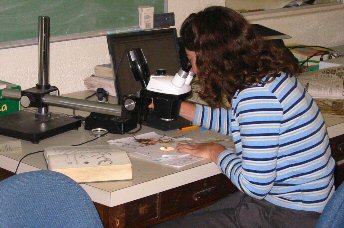 Collections-Based Research
Collections-Based Research
- Taxonomic research detailing the genera and species in a plant group, describing new species, and including keys and descriptions to differentiate species
- Floristic research describing the plant life in a specific geographic area
- Morphological and molecular systematic research analyzing the evolutionary relationships between plant taxa
Education
- Design and develop the website to communicate information about the herbarium’s resources and services
- Provide instructional support (including class tours) for classes in the following University of Florida departments/programs: Agronomy, Anthropology, Botany, Ecology, Entomology, Environmental Horticulture, Forestry, Geography, Landscape Architecture, Museum Studies, Wildlife Ecology, and Zoology
- Contribute to research for the development of museum exhibits
Public Service
- Plant Identification and Information Service provided to extension agents and the general public (both traditional specimen and digital image submissions)
- Develop informational materials for the general public on local flora, plant taxonomy, and plant hazards
Where to go for more information
Publications
- Bridson, D. & L. Forman, eds. 1998. The Herbarium Handbook, 3rd ed. Royal Botanic Gardens, Kew, Great Britain.
- DeWolf, G.P., Jr. 1968. Notes on Making an Herbarium. Arnoldia 28(8/9): 69-111.
- Fosberg, F.R. & M.-H. Sachet. 1965. Manual for Tropical Herbaria. Regnum Vegetabile, Vol. 39. International Bureau for Plant Taxonomy and Nomenclature, Utrecht, Netherlands.
- Holmgren, P.K., N.H. Holmgren & L.C. Barnett. 1990. Index Herbariorum: Part I: The Herbaria of the World. 8th ed. Regnum Vegetabile, Vol. 120. For International Association for Plant Taxonomy by New York Botanical Garden, Bronx, NY.
- Imes, R. 1990. The Practical Botanist. Simon and Schuster, New York.
- Leenhouts, P.W. 1968. A Guide to the Practice of Herbarium Taxonomy. Regnum Vegetabile, Vol. 58. International Bureau for Plant Taxonomy and Nomenclature of the International Association for Plant Taxonomy, Utrecht, Netherlands.
- Metsger, D.A. & S.C. Byers (eds.). 1999. Managing the Modern Herbarium: An Interdisciplinary Approach. Published jointly by Society of the Preservation of Natural History Collections with The Royal Ontario Museum Centre for Biodiversity and Conservation Research, Washington, D.C.
- R.M. Baldini, G. Cristofolini, &C. Aedo. 2022. The extant herbaria from the Sixteenth Century: a synopsis. Webbia. Journal of Plant Taxonomy and Geography 77(1): 23-33. doi: 10.36253/jopt-13038
- Smith, E.E., Jr. 1971. Preparing Herbarium Specimens of Vascular Plants. U.S.D.A. Agriculture Information Bulletin No. 348. Washington, D.C.
- Thiers, B.M. 2020. Herbarium: The Quest to Preserve and Classify the World’s Plants. New York Botanical Garden.
Web Pages
- Herbaria and Specimens: What are They? By Diana Horton of the University of Iowa Herbarium
